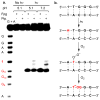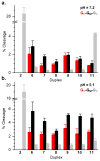DNA Damage Emanating From a Neutral Purine Radical Reveals the Sequence Dependent Convergence of the Direct and Indirect Effects of γ-Radiolysis
- PMID: 29190086
- PMCID: PMC5729073
- DOI: 10.1021/jacs.7b10942
DNA Damage Emanating From a Neutral Purine Radical Reveals the Sequence Dependent Convergence of the Direct and Indirect Effects of γ-Radiolysis
Abstract
Nucleobase radicals are the major intermediates generated by the direct (e.g., dA•+) and indirect (e.g., dA•) effects of γ-radiolysis. dA• was independently generated in DNA for the first time. The dA•+/dA• equilibrium, and consequently the reactivity in DNA, is significantly shifted toward the radical cation by a flanking dA. Tandem lesions emanating from dA• are the major products when the reactive intermediate is flanked by a 5'-dGT. In contrast, when dA• is flanked by dA, the increased dA•+ pKa results in DNA damage arising from hole transfer. This is the first demonstration that sequence effects lead to the intersection of the direct and indirect effects of ionizing radiation.
Figures








Similar articles
-
Traceless Tandem Lesion Formation in DNA from a Nitrogen-Centered Purine Radical.J Am Chem Soc. 2018 May 23;140(20):6400-6407. doi: 10.1021/jacs.8b02828. Epub 2018 May 8. J Am Chem Soc. 2018. PMID: 29738242 Free PMC article.
-
Evidence for glycosidic bond rotation in a nucleobase peroxyl radical and its effect on tandem lesion formation.J Org Chem. 2004 Oct 15;69(21):6974-8. doi: 10.1021/jo0492158. J Org Chem. 2004. PMID: 15471441
-
One-electron oxidation reactions of purine and pyrimidine bases in cellular DNA.Int J Radiat Biol. 2014 Jun;90(6):423-32. doi: 10.3109/09553002.2013.877176. Epub 2014 Apr 3. Int J Radiat Biol. 2014. PMID: 24369822 Free PMC article. Review.
-
Topics in free radical-mediated DNA damage: purines and damage amplification-superoxic reactions-bleomycin, the incomplete radiomimetic.Int J Radiat Biol. 1994 Nov;66(5):485-90. doi: 10.1080/09553009414551501. Int J Radiat Biol. 1994. PMID: 7527070
-
Reactions of oxyl radicals with DNA.Free Radic Biol Med. 1995 Jun;18(6):1033-77. doi: 10.1016/0891-5849(94)00209-3. Free Radic Biol Med. 1995. PMID: 7628729 Review.
Cited by
-
Synergistic effects on mutagenicity of tandem lesions containing 8-oxo-7,8-dihydro-2'-deoxyguanosine or Fapy•dG flanked by a 3' 5-formyl-2'-deoxyuridine in human cells.DNA Repair (Amst). 2023 Sep;129:103527. doi: 10.1016/j.dnarep.2023.103527. Epub 2023 Jun 24. DNA Repair (Amst). 2023. PMID: 37467631 Free PMC article.
-
Nitrogen-Centered Radicals Derived from Azidonucleosides.Molecules. 2024 May 14;29(10):2310. doi: 10.3390/molecules29102310. Molecules. 2024. PMID: 38792171 Free PMC article. Review.
-
Photochemical and Single Electron Transfer Generation of 2'-Deoxycytidin-N4-yl Radical from Oxime Esters.J Org Chem. 2023 Jun 2;88(11):7381-7390. doi: 10.1021/acs.joc.3c00646. Epub 2023 May 23. J Org Chem. 2023. PMID: 37220149 Free PMC article.
-
CO2 protects cells from iron-Fenton oxidative DNA damage in E. coli and humans.bioRxiv [Preprint]. 2024 Aug 26:2024.08.26.609766. doi: 10.1101/2024.08.26.609766. bioRxiv. 2024. Update in: Proc Natl Acad Sci U S A. 2024 Dec 3;121(49):e2419175121. doi: 10.1073/pnas.2419175121. PMID: 39253463 Free PMC article. Updated. Preprint.
-
Interplay of Guanine Oxidation and G-Quadruplex Folding in Gene Promoters.J Am Chem Soc. 2020 Jan 22;142(3):1115-1136. doi: 10.1021/jacs.9b11050. Epub 2020 Jan 9. J Am Chem Soc. 2020. PMID: 31880930 Free PMC article.
References
-
- von Sonntag C. Free-Radical-Induced DNA Damage and Its Repair. Springer-Verlag; Berlin: 2006.
-
- Galm U, Hager MH, Van Lanen SG, Ju J, Thorson JS, Shen B. Chem Rev. 2005;105:739–758. - PubMed
-
- Bamatraf MMM, O’Neill P, Rao BSM. J Phys Chem B. 2000;104:636–642.
-
- Dizdaroglu M, Jaruga P. Free Rad Res. 2012;46:382–419. - PubMed
Publication types
MeSH terms
Substances
Grants and funding
LinkOut - more resources
Full Text Sources
Other Literature Sources

